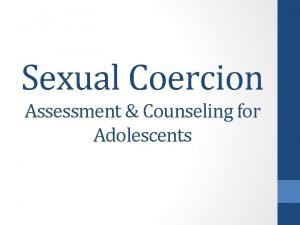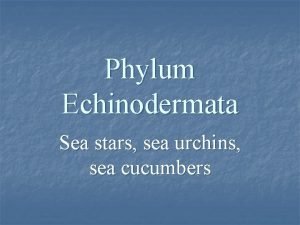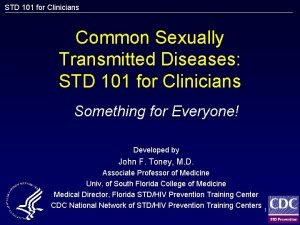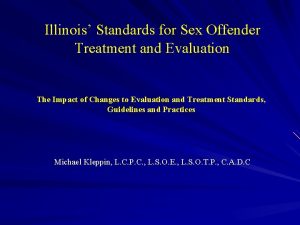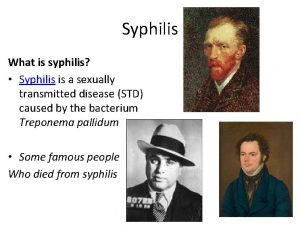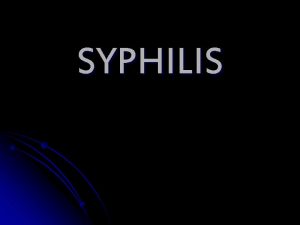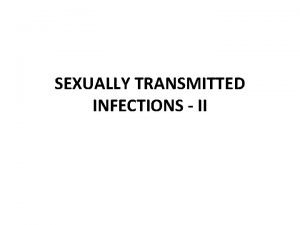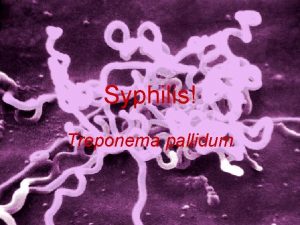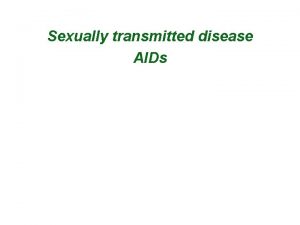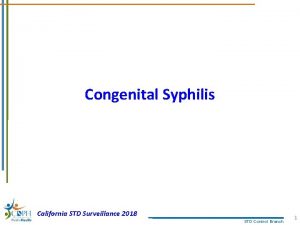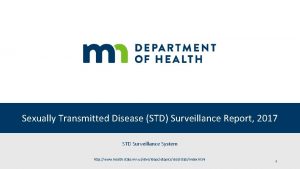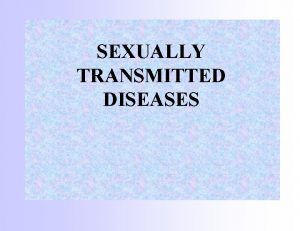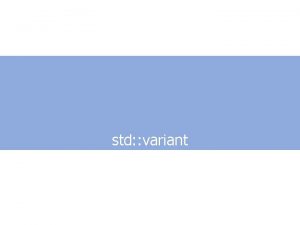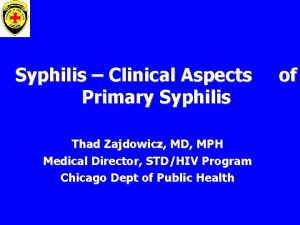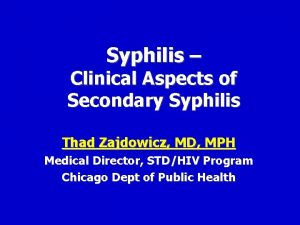STD AND RTI SYPHILIS Syphilis is a sexually


































- Slides: 34

STD AND RTI


SYPHILIS �Syphilis is a sexually transmitted disease caused by the spirochete bacterium Treponema pallidum

CLINICAL FEATURES q PRIMARY STAGE Ø Small red spot is noticed on the penis 3 – 4 weeks after sexual intercourse Ø Painless develop to a well defined hard sore or hard chancre Ø A painless bubo in the groin Ø Glands in neck, axilla and epitrochlear region q SECONDARY STAGE Ø Sore throat, anemia, skin rashes, enlargement of glands Ø Pain and swelling in bones and joints Ø Soft warty condylomata are seen on the moist surface Ø Ulcer in throat Ø White mucous patch inside the cheeks

CAUSATIVE AGENT �TREPONEMA PALLIDUM �Dies rapidly outside the body �It is killed by drying, heating, ordinary antiseptics

SOURCE OF INFECTION �Saliva �Urine �Broken and ulcerating gum in throat �Skin may be infective

MODE OF TRANSMISSION � Sexual intercourse � Rarely by kissing � Saliva � Semen � Blood � Vaginal discharges � Congenital syphilis � Extragenital infection

PERIOD OF COMMUNICABILITY �As long as primary sore, condylomata, mucous patches or ulcerating gummata are not healed

SUSCEPTIBILITY AND RESISTANCE �Susceptibility in general �No natural immunity

INCUBATION PERIOD � 10 days to 10 weeks �Average 3 weeks

METHOD OF CONTROL…Contd q PREVENTIVE MEASURES Ø Congenital syphilis • Serological examination and treatment Ø Acquired syphilis • Health and sex education • Personal prophylaxis before, during and after exposure • Control of prostitution • Early diagnosis and treatment

METHOD OF CONTROL q. CONTROL OF PATIENTS, CONTACTS AND THE IMMEDIATE ENVIRONMENT Ø Report to health authority Ø Isolation Ø Contacts • Congenital syphilis ( All immediate family members) • Primary syphilis (sexual contact preceding 3 months) • Secondary syphilis (sexual contact preceding 6 months) Ø Specific treatment • Acquired syphilis (Benzathine penicillin G) • Congenital syphilis (Procaine penicillin ) • In case of pencillin allergy erythromycin or tetracycline is given

GONORRHOEA �Gonorrhea is a sexually transmitted disease caused by the bacteria Neisseria Gonorrhoeae or Gonococcus

CLINICAL FEATURES q MALE Ø Inflammation of urethra Ø Acute burning sensation with pain and pus discharge while passing urine Ø Infection spread to prostate, seminal vesicles, bladder, renal pelvis or rectum q FEMALE Ø Inflammation of urethra Ø Acute burning sensation with pain and pus discharge while passing urine Ø Infection spread to uterus, tubes, peritoneum and bartholin glands INFECTION MAY SPREAD THROUGH BLOOD TO HEART, MENINGES, JOINTS , MUSCLES, TENDONS AND EYE

COMPLICATIONS �Urethral stricture in males �PID in females �Infertility

DIAGNOSIS �It is a gram negative diplococci �Male urethral smear �Female smear from cervix and uterus �No reliable serological test are available

CAUSATIVE AGENT �Neisseria Gonorrhoeae �Kidney shaped diplococci

SOURCE OF INFECTIONPERIOD OF INFECTIVITY �Untreated cases are infective for months �Women form largest reservoir

MODE OF SPREAD � Sexual intercourse � Oropharyngeal gonorrhea due to orogenital sexual contact � Infected towels � Purulent conjunctivitis � Ophthalmia neonatorum due to infection in the birth canal

INCUBATION PERIOD � 2 – 7 days

METHOD OF CONTROL q. PREVENTIVE MEASURES q TREATMENT �Procaine pencillin G �Pencillin allergy tetracycline or erythromycin �Sex partner should be treated q OPTHALMIA NEONATORUM ü Pencillin injection ü Pencillin eye drop

TRICHOMONAL VAGINITIS AND URETHRITIS �Trichomonal vaginitis is a protozoal infection of the vagina and the urethra caused by a flagellate parasite – Trichomonas vaginalis

CAUSATIVE ORGANISM � Trichomonas vaginalis � The parasite lives in the vagina and urethra of females � And in male urethra

DIAGNOSIS �By detecting parasite in vaginal and urethral discharge

CLINICAL MANIFESTATION q MALE Ø Mucoid discharge Ø Slight irritation q FEMALE Ø Vulvar irritation Ø Frothy yellowish discharge Ø Putrid odour of discharge

TREATMENT q Metronidazole 200 mg thrice daily for 7 days

CHANCROID (SOFT SORE) q FEATURES Ø Small red lesion appear on the genitals as a papule or vesicle which becomes a pustule and ulcerated Ø Ulcers multiple and painful Ø Soft bleeding surface Ø Ragged undermined edges Ø Lymph glands are enlarged, tender and matted Ø Suppuration of lymph glands Ø Phimosis in male Ø Extragenital lesions on the lips, tongue, chin, breast and umbilicus

CHANCROID (SOFT SORE) EPIDEMIOLOGY q CAUSATIVE AGENT Ø Duncrey bacillus (H. duncrey) Ø Abrasions, cut and wound predispose to infection q PERIOD OF INFECTIVITY Ø Person remains infective till the lesions are healed q INCUBATION PERIOD Ø 2 -5 days , 24 hrs if there is abrasion q TREATMENT Ø Sulphadimidine 4 gm daily for 10 -15 days in divided doses Ø Tetracycline 0. 5 gm four times a day for 10 days

LYMPHOGRANULOMA VENEREUM � LGV is a sexually transmitted disease caused by the organism Chlamydia trachomatis �It is more common in South India

LYMPHOGRANULOMA VENEREUM q CAUSATIVE ORGANISM Ø Chlamydia trachomatis q ROUTE OF ENTRY Ø Breaks in the skin Ø It can cross epithelial cell layer of the mucous membranes q INCUBATION PERIOD Ø 3 – 30 days

LYMPHOGRANULOMA VENEREUM q. CLINICAL FEATURES Ø Primarily an infection of the lymphatics and lymph nodes Ø Climatic bubo Ø Iguinal glands are enlarged and matted, forming tender mass and which may burst Ø Discharging sinuses Ø Ano rectal stricture Ø Urethral lesions with fistulae Ø Fever Ø Body aches

LYMPHOGRANULOMA VENEREUM q DIAGNOSIS Ø Serological testing q TREATMENT Ø Surgical correction of deformity Ø Doxycycline, Erythromycin and Tetracycline

GRANULOMA INGUINALE(DONOVANOSIS) q CAUSATIVE ORGANISM Ø Calymmatobacterium granulomatis (Donovanis granulomatis) q MODE OF TRANSMISSION Ø Contact with lesions q INCUBATION PERIOD Ø 8 – 80 days q SPECIFIC TREATMENT Ø Tetracycline 500 mg four times daily for 10 days Ø Clotrimoxazole and chloramphenicol

GRANULOMA INGUINALE(DONOVANOSIS) q CLINICAL FEATURES Ø Lesions appear on the genitals as a hard papule or vesicles that are ulcerated Ø Floor of the ulcer is painless with red velvety granulation Ø Extra genital lesions occur in the warm and moist area (scrotum, labia and vagina)
 Chapter 25 sexually transmitted infections and hiv/aids
Chapter 25 sexually transmitted infections and hiv/aids Chapter 24 sexually transmitted diseases and hiv/aids
Chapter 24 sexually transmitted diseases and hiv/aids Body structure of porifera
Body structure of porifera Rti and good governance
Rti and good governance How do whales reproduce sexually
How do whales reproduce sexually Phylum platyhelminthes segmentation
Phylum platyhelminthes segmentation Invertebrates characteristics
Invertebrates characteristics What is sexually dimorphic mean
What is sexually dimorphic mean Coercion
Coercion Protoctista reproduction
Protoctista reproduction Was i sexually abused as a child quiz
Was i sexually abused as a child quiz Feather star anatomy
Feather star anatomy Animal like protists
Animal like protists Chapter 24 lesson 1 sexually transmitted diseases
Chapter 24 lesson 1 sexually transmitted diseases Define arouse sexually
Define arouse sexually Do worms reproduce sexually or asexually
Do worms reproduce sexually or asexually Sexual harassment training quiz
Sexual harassment training quiz Example of a sexual propagation
Example of a sexual propagation Do flatback sea turtles reproduce sexually or asexually
Do flatback sea turtles reproduce sexually or asexually Sexually transmitted diseases
Sexually transmitted diseases Radial symmetry
Radial symmetry Sexually transmitted diseases
Sexually transmitted diseases Frustrated shipping
Frustrated shipping Sexually transmitted disease
Sexually transmitted disease How do birds mate
How do birds mate Sexual dimorphism
Sexual dimorphism Sexually dangerous persons act illinois
Sexually dangerous persons act illinois Www.serp.doe.louisiana
Www.serp.doe.louisiana Rti graph
Rti graph Writing interventions
Writing interventions Rti scheduler
Rti scheduler Rti behavior checklist
Rti behavior checklist Rti interventions examples
Rti interventions examples Rti act 2005 introduction
Rti act 2005 introduction Hmrc rti gtax
Hmrc rti gtax








